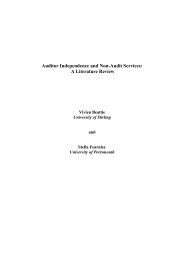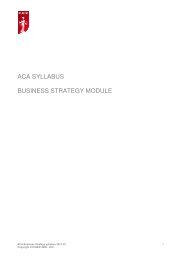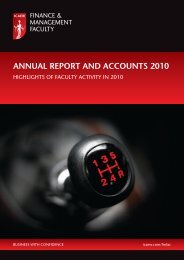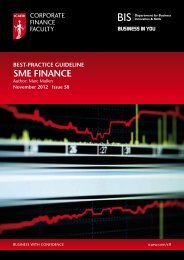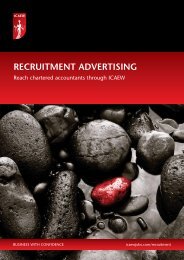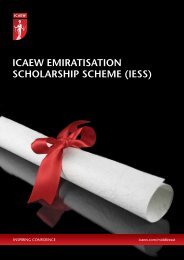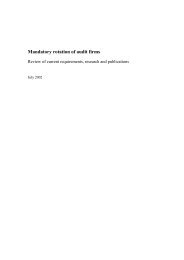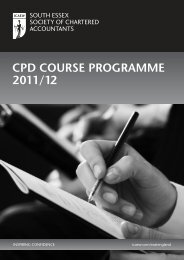In terms of whe<strong>the</strong>r <strong>the</strong> relevant <strong>public</strong>’s <strong>in</strong>dividual wants need to be adjusted to arrive at anoverall outcome that can be considered to be <strong>for</strong> <strong>the</strong> greater good, <strong>the</strong> considerations aboveact as an overall sense check <strong>for</strong> <strong>the</strong> advocate of <strong>the</strong> <strong>public</strong> <strong>in</strong>terest action. Is <strong>the</strong>re reason tosuppose that <strong>the</strong> <strong>public</strong> has been mis<strong>in</strong><strong>for</strong>med or misled? Does <strong>the</strong> <strong>in</strong>teraction of <strong>in</strong>dividualactions produce an undesirable result as a result of <strong>in</strong>teractions when aggregated?7.2 Externalities and <strong>public</strong> goods7.2.1 Establish<strong>in</strong>g how <strong>public</strong> goods and o<strong>the</strong>r externalities should be dealt withThe existence of externalities and <strong>public</strong> goods is a fur<strong>the</strong>r factor that can result <strong>in</strong> <strong>in</strong>dividualwants not produc<strong>in</strong>g a result that is <strong>for</strong> <strong>the</strong> greater good overall.For <strong>public</strong> goods such as roads, most of which are funded by <strong>public</strong> taxation regardless of<strong>in</strong>dividual use, market rationality tends to result <strong>in</strong> people underestimat<strong>in</strong>g <strong>the</strong>ir cost. Weassume <strong>the</strong> obligations can be passed to o<strong>the</strong>rs while we reta<strong>in</strong> use of <strong>the</strong> good: 144 marg<strong>in</strong>al usedoes not result <strong>in</strong> marg<strong>in</strong>al costs to <strong>the</strong> <strong>in</strong>dividual. Examples <strong>in</strong>clude common pasture, where<strong>in</strong>dividuals will tend to overgraze <strong>the</strong>ir own animals, even though it dim<strong>in</strong>ishes <strong>the</strong> pastureand thus <strong>the</strong> wealth of <strong>the</strong> village as a whole, and overfish<strong>in</strong>g <strong>in</strong> <strong>in</strong>ternational waters, whicheventually exhausts <strong>the</strong> fish<strong>in</strong>g stock. 145 Environmental issues such as pollution, overexploitationof natural resources, and depletion of wildlife also derive from <strong>the</strong>ir be<strong>in</strong>g treated as commonproperty resources. 146 Aga<strong>in</strong>, it requires some sort of central authority to address <strong>the</strong>se issues,although as discussed below, <strong>the</strong>re are ways of push<strong>in</strong>g <strong>the</strong>m <strong>in</strong>to <strong>the</strong> <strong>in</strong>dividual doma<strong>in</strong>.7.2.2 Causes of externalitiesExternalities result <strong>in</strong> sub-optimum resource allocation because <strong>the</strong>re is no clear economic effecton those potentially us<strong>in</strong>g <strong>the</strong> resources, of <strong>the</strong>ir usage or not. Some activities are externalitiesbecause <strong>the</strong> market does not deal with <strong>the</strong>m. An example is pollution, where <strong>the</strong> cost is borneby <strong>the</strong> <strong>public</strong> as a whole ra<strong>the</strong>r than <strong>the</strong> polluter. This can be addressed by governmentsthrough direct regulation such as required actions or prohibitions, or <strong>in</strong>ternalis<strong>in</strong>g <strong>the</strong> activitiesto <strong>the</strong> market through mechanisms such as taxation, subsidies, and market-mirror<strong>in</strong>g schemes147 148such as emissions trad<strong>in</strong>g.O<strong>the</strong>r externalities arise through <strong>the</strong> general <strong>public</strong>’s choice. Sometimes this emerges throughpracticality. An example is defence where it would be difficult to work out how to charge <strong>for</strong>it on a user-pays pr<strong>in</strong>ciple, and <strong>the</strong>re is also <strong>the</strong> free-rider problem: how would those with<strong>in</strong>a country who do not pay, be excluded from benefit? If <strong>the</strong>y are not excluded, why shouldo<strong>the</strong>rs pay?Sometimes goods and services become common <strong>for</strong> social purposes. Governments and o<strong>the</strong>rrelevant authorities need to balance economic efficiency and social cohesion. This is particularlyimportant <strong>in</strong> <strong>the</strong> context of <strong>public</strong> services, ie, those which are provided from <strong>the</strong> <strong>public</strong>purse ra<strong>the</strong>r than be<strong>in</strong>g recharged to users, and which thus become externalities to thoseusers. Public op<strong>in</strong>ion, shaped by slow-mov<strong>in</strong>g <strong>for</strong>ces such as social <strong>in</strong>stitutions and collectivememories, has been attributed as a key cause of ensur<strong>in</strong>g that welfare states survive globalpressures. 149 Op<strong>in</strong>ion differs on <strong>the</strong> extent to which <strong>the</strong>re should be <strong>public</strong> goods, even with<strong>in</strong>one country. For example, <strong>in</strong> Belgium, <strong>the</strong>re have been seen to be different views between<strong>the</strong> Dutch and French speak<strong>in</strong>g populace as to what should be <strong>in</strong>cluded with<strong>in</strong> such services,<strong>the</strong> latter consistently expect<strong>in</strong>g higher levels of universal service. 150What <strong>the</strong>re seldom seems to be with<strong>in</strong> a society is a coherent debate on this, items <strong>in</strong>steadbe<strong>in</strong>g picked off and argued about on a case-by-case basis.It follows that those advocat<strong>in</strong>g or assess<strong>in</strong>g a <strong>public</strong> <strong>in</strong>terest measure may need to consider:• not only how to deal with common goods or services, but also• what relevant factors should be treated as common goods or services.From <strong>the</strong> perspective of a <strong>public</strong> <strong>in</strong>terest action, externalities can feature even where <strong>the</strong>re donot appear, on <strong>the</strong> face of it, to be common goods or services. We have already noted thatmeasures such as Gross Domestic Product do not tell <strong>the</strong> full story because of <strong>the</strong> omission of144Po-Keung, ‘Profit and Morality: Problems <strong>in</strong> Bus<strong>in</strong>ess Ethics’.145Hard<strong>in</strong>, ‘The Tragedy of <strong>the</strong> Commons’.146Smith R, quoted <strong>in</strong> Partridge, ‘Conscience of a Progressive’.147Tanguay, Lanoie and Moreau, ‘Environmental policy, <strong>public</strong> <strong>in</strong>terest and political market’.148<strong>ICAEW</strong>, Susta<strong>in</strong>ability: The Role of Accountants.149Brooks and Manza, Why Welfare States Persist: The Importance of Public Op<strong>in</strong>ion <strong>in</strong> Democracies.150Van de Walle, ‘The Impact of Public Service Values on Services of General Interest’.48Constra<strong>in</strong>ts to wants
qualitative characteristics of what people actually want. They also do not consider <strong>the</strong> overallsocial effect of <strong>the</strong> apparent output, <strong>in</strong>discrim<strong>in</strong>ately mix<strong>in</strong>g output that satisfies needs, outputthat satisfies ‘needs’ generated artificially through, <strong>for</strong> example, advertis<strong>in</strong>g, and social costssuch as accidents, wars and litigation. 151Panel 7.3: <strong>ICAEW</strong> and externalitiesCommon goods are not a particularly key issue <strong>in</strong> <strong>the</strong> context of accountancy professionalconduct, although some professional activities are designed to achieve what could beregarded as positive externalities. For example, <strong>ICAEW</strong> and some o<strong>the</strong>r professional bodiescomment on matters that are wider than those immediately relevant to <strong>the</strong>ir members andmake some thought leadership and guidance material free to all, <strong>in</strong> order to raise standardsmore generally <strong>in</strong> <strong>the</strong> economy. Ano<strong>the</strong>r perspective would be that <strong>the</strong>y do this to enhance<strong>the</strong>ir own reputation and thus that of <strong>the</strong>ir members, and that this work does not fall to betreated as an externality.<strong>ICAEW</strong>’s thought leadership work covers, among o<strong>the</strong>r areas, f<strong>in</strong>ancial report<strong>in</strong>g andsusta<strong>in</strong>ability, both areas <strong>in</strong> which account<strong>in</strong>g <strong>for</strong> externalities is a key challenge andopportunity.It was noted above that people will tend to discount <strong>the</strong> severity and probability of futuredownsides, when <strong>the</strong> prospect of an upside is more immediate. The same can hold true <strong>in</strong>reverse. <strong>ICAEW</strong> and o<strong>the</strong>r professional bodies that seek to follow a <strong>public</strong> <strong>in</strong>terest perspectivewill sometimes f<strong>in</strong>d that such a perspective requires a long-term view to be taken, that canresult <strong>in</strong> short term disadvantages. With <strong>the</strong> time discount<strong>in</strong>g referred to, it is not alwaysnatural to accept def<strong>in</strong>ite short term sacrifices <strong>for</strong> potential longer term ga<strong>in</strong>s. Ultimately <strong>the</strong>equation has to be that <strong>the</strong> long-term ma<strong>in</strong>tenance of trust <strong>in</strong> <strong>the</strong> profession is <strong>in</strong> both <strong>the</strong><strong>public</strong> <strong>in</strong>terest and <strong>the</strong> <strong>in</strong>terests of members.7.3 Time effectsTwo issues arise. First, balanc<strong>in</strong>g immediate concerns aga<strong>in</strong>st future impacts. Human naturediscounts <strong>the</strong> severity and probability of future downsides, when <strong>the</strong> prospect of an upsideis more immediate. 152 More positively <strong>the</strong>re is an argument <strong>for</strong> putt<strong>in</strong>g greater weight on <strong>the</strong>needs of <strong>the</strong> present based on probability: present needs are concrete, whereas <strong>the</strong>re are manypossible futures so <strong>the</strong> <strong>for</strong>ce of future <strong>in</strong>terests is diluted by <strong>the</strong>ir cont<strong>in</strong>gency. 153 This does notmean that future <strong>in</strong>terests can be ignored. There is an <strong>in</strong>creas<strong>in</strong>g call <strong>for</strong> development to besusta<strong>in</strong>able, which has been def<strong>in</strong>ed as, <strong>for</strong> example: ‘development that meets <strong>the</strong> needs of <strong>the</strong>present without compromis<strong>in</strong>g <strong>the</strong> ability of future generations to meet <strong>the</strong>ir own needs.’ 154Panel 7.4: Example of guidel<strong>in</strong>es to deal with <strong>the</strong> futureThe US National Academy of Public Adm<strong>in</strong>istration applies four pr<strong>in</strong>ciples:• ‘Trusteeship’ – an obligation to protect future <strong>in</strong>terests;• ‘Susta<strong>in</strong>ability’ – no generation should deprive future generations of a quality of lifecomparable to that currently experienced;• ‘Cha<strong>in</strong> of obligations’ – each generation’s priority is <strong>the</strong> liv<strong>in</strong>g and succeed<strong>in</strong>ggenerations, which recognises <strong>the</strong> ‘concrete current <strong>in</strong>terests’ argument above; and• ‘Precaution’ – Actions pos<strong>in</strong>g a realistic threat of irreversible harm should be avoided <strong>in</strong><strong>the</strong> absence of a compell<strong>in</strong>g, countervail<strong>in</strong>g need. 155The second issue is about different expectations. The world’s affairs are <strong>in</strong>creas<strong>in</strong>gly <strong>in</strong>terrelated,people’s reactions and behaviours are complex and often difficult to predict and eventsoccur beyond anyone’s control. In short, <strong>the</strong> future is uncerta<strong>in</strong>. As decisions about <strong>the</strong> <strong>public</strong><strong>in</strong>terest often <strong>in</strong>volve predict<strong>in</strong>g <strong>the</strong> future, <strong>the</strong>re will <strong>in</strong>evitably be different views. What isoften seen as a debate about what is <strong>in</strong> <strong>the</strong> <strong>public</strong> <strong>in</strong>terest might actually be an agreementabout what is <strong>in</strong> <strong>the</strong> <strong>public</strong> <strong>in</strong>terest, but a disagreement about what reactions to particularmeasures will be.151Capra and Henderson, Qualitative Growth.152Marnet, ‘History Repeats Itself: The Failure of Rational Choice Models <strong>in</strong> Corporate Governance’, Gwilliam and Marnet,Audit With<strong>in</strong> <strong>the</strong> Corporate Governance Paradigm: a Cornerstone Built on Shift<strong>in</strong>g Sand.153Pleasence and Maclean, ‘The Public Interest’.154The Bruntland Report quoted <strong>in</strong> <strong>ICAEW</strong>, Susta<strong>in</strong>able Bus<strong>in</strong>ess.155Quoted <strong>in</strong> US National Academy of Public Adm<strong>in</strong>istration, Decid<strong>in</strong>g <strong>for</strong> <strong>the</strong> Future: Balanc<strong>in</strong>g Risks, Costs and Benefits FairlyAcross Generations.Constra<strong>in</strong>ts to wants49
- Page 1 and 2: ACTING IN THE PUBLIC INTEREST:A FRA
- Page 3: ACTING IN THE PUBLIC INTEREST:A FRA
- Page 9: Our framework is based around the k
- Page 12 and 13: The answers to these questions will
- Page 14 and 15: 2. INTRODUCTION2.1 Concepts of the
- Page 16 and 17: Accordingly, this report addresses
- Page 18 and 19: Panel 2.4: ICAEW and its public int
- Page 20 and 21: The Mediterranean republics needed
- Page 22 and 23: We set out a framework for discussi
- Page 24 and 25: 3. CREDENTIALS FOR INVOKINGTHE PUBL
- Page 26 and 27: By and large producers operate in s
- Page 29 and 30: the UK government set up a ‘Commi
- Page 31 and 32: 4. APPLICABILITY OF THE PUBLIC INTE
- Page 33 and 34: to be a public interest matter: fir
- Page 35: This highlights that there may be p
- Page 38 and 39: 5. THE RELEVANT PUBLIC5.1 ScopeIn o
- Page 40 and 41: 5.3 Geographical exclusionsGeograph
- Page 42 and 43: 6. THE RELEVANT PUBLIC’S WANTS6.1
- Page 44 and 45: • work, that is having some, havi
- Page 46 and 47: Panel 6.3: Weisbrod’s public inte
- Page 48 and 49: Having sought out representative op
- Page 50 and 51: 7. CONSTRAINTS TO WANTS7.1 Self-int
- Page 54 and 55: Panel 7.5: Management of national d
- Page 56 and 57: Panel 7.6: ICAEW and clarity of val
- Page 58 and 59: 8. AGGREGATION AND DECISION8.1 Base
- Page 60 and 61: Other ethical decision-making model
- Page 62 and 63: In this instance, while national se
- Page 65 and 66: 9. IMPLEMENTATIONA proposed action
- Page 67 and 68: • giving up where targets seem un
- Page 69 and 70: 9.2.1 Government authorityAt the st
- Page 71 and 72: 9.3 Infrastructure and support tool
- Page 73 and 74: 12. The framework proposes a signif
- Page 75 and 76: ibliographyAdler, Jonathan H, Perve
- Page 77 and 78: Goldstein, Eric A, ‘Defining the
- Page 79 and 80: Persky, Joseph, ‘Retrospectives:
- Page 81: The ICAEW is a founder member of th



